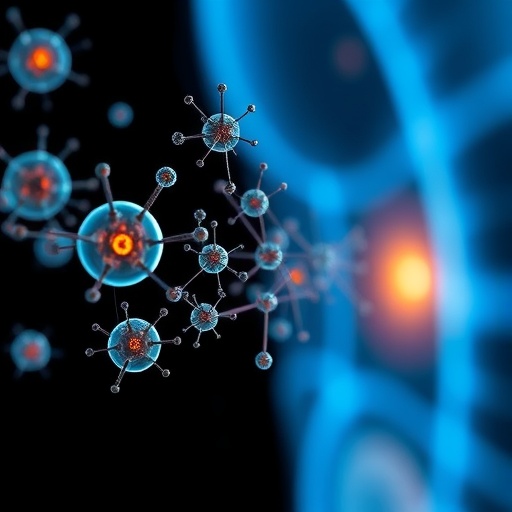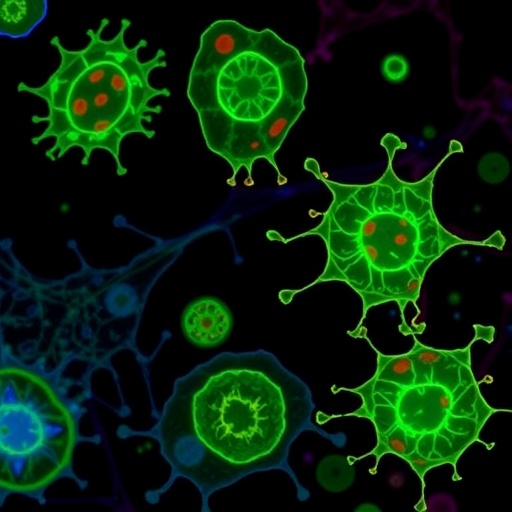
In a groundbreaking advancement in cancer therapy, researchers have unveiled a novel approach that combines microwave-assisted drug delivery with cutting-edge nanotechnology to target skin cancer more effectively. This pioneering study focuses on titanium dioxide/rose Bengal conjugated chitosan nanoparticles (TiO₂/RB@CSNP) designed to revolutionize micro-photodynamic therapy (MWPDT), offering promising results both in laboratory-grown human cancer cells and in live animal models. Such innovation marks a significant leap toward localized, minimally invasive skin cancer treatments.
Micro-photodynamic therapy (MWPDT) uniquely merges the principles of photodynamic therapy (PDT) and microwave dynamic therapy (MWDT), utilizing sensitizing agents that become activated upon exposure to light and microwaves. This dual activation significantly amplifies the therapeutic impact, enabling targeted destruction of tumor cells while sparing surrounding healthy tissue. Despite its potential, the application of MWPDT has been hampered by suboptimal tumor targeting and limited penetration of sensitizers into the tumor depths, often resulting in reduced efficacy.
The central innovation in this study lies in employing chitosan-based nanoparticles conjugated with titanium dioxide and rose Bengal, a photosensitizer with known antitumor activity. Chitosan, a biocompatible and biodegradable natural polymer, serves as an ideal drug delivery matrix, enabling the nanoparticles to penetrate deeply into the tumor microenvironment and deliver the sensitizers precisely where needed. The conjugation of TiO₂ and rose Bengal enhances the photoactive properties of the nanoparticles, making them highly responsive to both microwave and laser irradiation.
Extensive in vitro experiments were carried out using A-375 human skin cancer cell lines to assess the anticancer efficacy of TiO₂/RB@CSNP. The researchers observed that treatment with these nanoparticles led to a statistically significant decrease in cell viability in a dose-dependent manner. The therapeutic effect was further characterized by a notable slowing of the cell cycle in the G0/G1 phase, indicating inhibition of cancer cell proliferation. Importantly, the treated cells exhibited elevated levels of apoptotic markers, alongside increases in necrosis and autophagic cell death, confirming multiple modes of cancer cell eradication.
To translate these findings to a more physiological setting, the study employed an established in vivo model using Swiss albino mice induced with skin cancer via topical application of carcinogens 7,12-dimethylbenz[a]anthracene (DMBA) and croton oil. After tumor induction, the mice were treated daily with TiO₂/RB@CSNP, combined with selective exposure to infrared laser light, microwave radiation, or both, for brief sessions of three minutes over two weeks. This regimented treatment yielded marked tumor regression and reduced proliferation rates.
Molecular analysis of tumor tissue revealed that the nanoparticle therapy induced upregulation of pro-apoptotic and antiproliferative genes, including caspase 3 and 9, p53, Bax, and tumor necrosis factor-alpha (TNF-α). At the same time, expression of antiapoptotic gene Bcl-2 and proangiogenic vascular endothelial growth factor (VEGF) was significantly suppressed. This genetic modulation suggests a robust activation of cellular death pathways alongside the disruption of tumor angiogenesis, a critical factor in tumor growth and metastasis.
Furthermore, biochemical assays indicated that oxidative stress markers, notably malondialdehyde (MDA), were reduced after treatment, highlighting the antioxidant capability of the therapy. Concurrently, enzymatic antioxidants such as superoxide dismutase (SOD), glutathione reductase (GR), glutathione peroxidase (GPx), glutathione S-transferase (GST), catalase (CAT), along with nonenzymatic antioxidants like reduced glutathione (GSH) and total antioxidant capacity (TAC), were significantly elevated. These findings point toward a restoration of the antioxidative defense system in treated tissues, mitigating oxidative damage that often accompanies cancer progression.
The safety profile of TiO₂/RB@CSNP was also reassuring, with renal (urea and creatinine) and hepatic (alanine transaminase [ALT] and aspartate transaminase [AST]) markers remaining within normal limits post-treatment. This indicates minimal systemic toxicity, an essential consideration for any therapeutic agent, especially those involving nanoparticulate delivery systems.
One of the pivotal mechanisms underlying this therapy’s success is the dual activation of the nanoparticles by both microwave radiation and laser light. This synergy appears to enhance reactive oxygen species (ROS) generation selectively within cancer cells, which plays a crucial role in inducing apoptosis and disrupting tumor metabolism. Moreover, the microwave-assisted drug delivery improves the penetration and accumulation of nanoparticles in tumor tissues, overcoming the typical barriers posed by the dense extracellular matrix and hypoxic microenvironment characteristic of many solid tumors.
The implications of this research are far-reaching, particularly given the persistent challenges in treating skin cancer effectively without invasive procedures. The use of nanotechnology to mediate and amplify photodynamic effects, along with the innovative incorporation of microwave activation, could herald a new era of precision oncology. This approach not only targets malignant cells more accurately but also reduces the likelihood of damage to healthy skin, potentially enhancing patient outcomes and quality of life.
While the data are highly encouraging, further investigations are warranted to optimize dosing parameters, explore long-term effects, and evaluate the therapy across different skin cancer subtypes and stages. Clinical translation will require rigorous testing to validate these preclinical results, confirm safety and efficacy in humans, and develop practical treatment protocols amenable to clinical settings.
In conclusion, the study demonstrates that TiO₂/RB@CSNP, when activated through micro-photodynamic therapy, is a powerful and selective agent against skin cancer. This innovative platform harnesses the combined benefits of advanced nanoparticle design, dual-mode activation, and targeted drug delivery, delivering a promising, clinically relevant strategy for future cancer therapy regimens. The integration of microwave irradiation into photodynamic treatment paradigms represents a novel mechanism with substantial therapeutic potential.
Emerging from this work is a new vision for localized cancer treatment—one that minimizes systemic side effects while maximizing tumor control through smart nanomaterials activated by precise energy sources. As researchers continue to unravel the complexities of tumor biology and exploit technological advancements, the future of cancer therapy promises to be safer, more effective, and tailored to the unique characteristics of individual patients.
Such cutting-edge research offers hope for millions affected by skin cancer globally, underscoring the importance of interdisciplinary collaboration between materials science, photomedicine, and oncology. Combining these fields provides a blueprint for innovative solutions that transcend traditional therapeutic limitations and usher in the next generation of cancer treatments.
This pioneering work resonates with the growing trend of utilizing nanoparticle-based sensitizers and alternate energy sources in cancer therapy. By bridging the gap between laboratory findings and clinical applicability, TiO₂/RB@CSNP activated by micro-photodynamic therapy exemplifies a paradigm shift in the fight against one of the most common and challenging malignancies—skin cancer.
Subject of Research: Microwave-assisted drug delivery of titanium dioxide/rose Bengal conjugated chitosan nanoparticles for micro-photodynamic therapy in skin cancer treatment.
Article Title: Microwave assisted drug delivery of titanium dioxide/rose Bengal conjugated chitosan nanoparticles for micro-photodynamic skin cancer treatment in vitro and in vivo.
Article References:
Abd El-Kaream, S.A., Hassan, N.A.M., Saleh, H.S.A. et al. Microwave assisted drug delivery of titanium dioxide/rose Bengal conjugated chitosan nanoparticles for micro-photodynamic skin cancer treatment in vitro and in vivo. BMC Cancer 25, 896 (2025). https://doi.org/10.1186/s12885-025-14285-8
Image Credits: Scienmag.com
DOI: https://doi.org/10.1186/s12885-025-14285-8
Tags: biocompatible nanoparticleschitosan-based drug deliveryinnovative cancer treatment approacheslocalized skin cancer treatmentmicro-photodynamic therapymicrowave-assisted drug deliveryminimally invasive cancer therapiesnanotechnology in cancer therapyrose Bengal photosensitizersensitizing agents in oncologytitanium dioxide nanoparticlestumor targeting techniques





